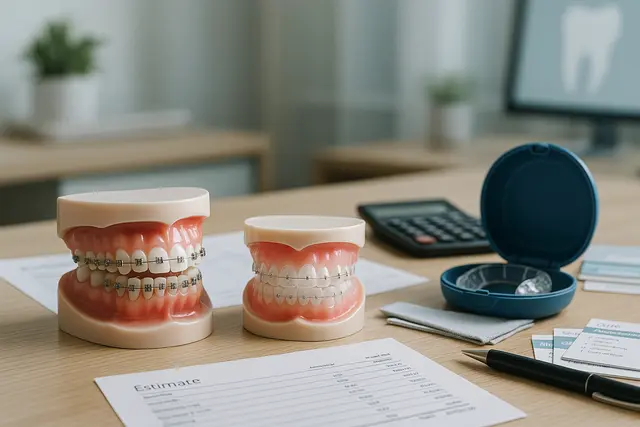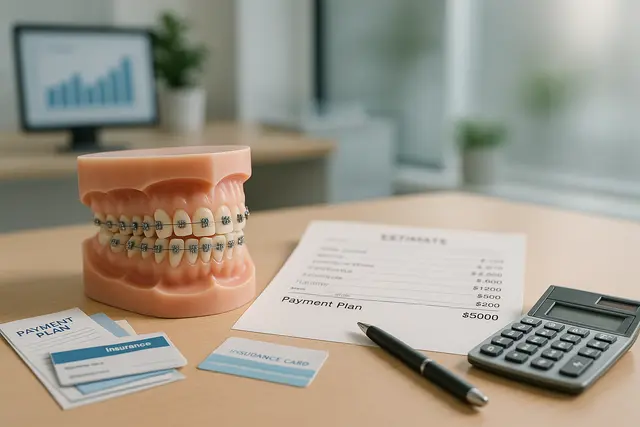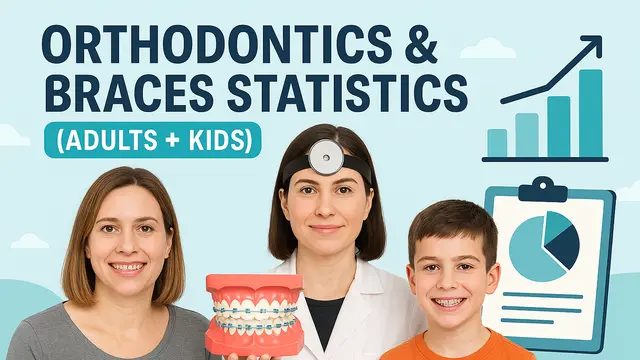Orthodontics
7 min read
Apr 03, 2025
Braces Cost Breakdown: Insurance Coverage, Financing Options, and Hidden Fees
Orthodontic care represents more than just aesthetic improvement, it’s a pathway to better dental health, function, and in many cases, confidence. But the financial commitment can be substantial. Whether you're evaluating options for yourself or a family member, understanding the total cost of braces requires more than just looking at a number.

You can almost hear your future self’s confident smile clicking into place the moment the brackets go on. Yet before you reach that life-changing grin, there’s one question that keeps people awake at night: “How much do braces cost, really?” This guide peels back the curtain on the full cost of treatment, explains why the price of braces can vary so wildly, and offers practical tactics to spread the cost without losing sleep, or your latte habit.
Cost of Braces
Braces can be a significant investment, and the overall cost of braces is more than just the number flashed at your first consultation. Prices for braces include X-rays, impressions, adjustments, and that glorious final retainer. In regions with a higher cost of living, the braces price naturally creeps up because staff wages, rent, and supplies all cost more.
Meanwhile, practices in quieter towns often charge less, but may book out months in advance. Understanding the cost early helps you budget and prevents sticker shock when the first invoice lands.
Factors Affecting the Cost
Several factors affect the cost of braces: the complexity of your bite, how long you need to wear braces, and the right type of braces for your lifestyle. The older you are, the stiffer the jawbone, which can make treatment longer and raise the total cost. Braces are placed by specialists who train for years, and that expertise isn’t cheap. Add in follow-up visits, emergencies (hello, popcorn mishap), and replacements for lost aligners, and each of these can influence the overall cost.
Type of Braces
Let’s talk gear. Traditional metal braces remain the reliable workhorse of orthodontic treatment. They function similarly to metal braces used decades ago, but technology has refined them for comfort. Metal braces typically ranges from $3,000 to $7,000 depending on location and treatment length. Ceramic braces, the less-flashy alternative to metal braces, blend with tooth color but may require gentle care.
Because they’re pricier to fabricate, they are often more expensive than traditional braces, expect a higher cost of roughly $4,000 to $8,500. Lingual braces hide behind your teeth; stealthy but tricky to clean and usually carrying the highest cost of $8,000 to $10,000. Clear aligners fall somewhere in the middle and can reduce the overall cost if your case is mild. Different types of braces give you options, but remember that the type of braces you choose will significantly impact the cost.
Average Cost of Braces
Across the United States, the average cost hovers between $5,500 and $6,500, but the cost of braces can vary significantly based on geography, clinic overhead, and whether your case requires extractions or appliances. Recent surveys peg the average cost of braces for adults at about $6,000, while the average cost of braces for teens trends a bit lower.
Metal braces but may require longer chair time than clear aligners, so their treatment cost can inch up if frequent adjustments are needed. Cost breakdown calculators on clinic websites can provide a detailed cost estimate, yet nothing beats an in-person assessment for a truly detailed cost.
Cost of Braces Without Insurance
Without insurance, the full cost sits squarely on your shoulders. The cost of braces without insurance might feel overwhelming, but many practices offer flexible payment options to soften the blow. Some dentists allow you to spread the cost of treatment over 24 months with zero interest, while others partner with third-party lenders.
If you need braces without coverage, ask whether they’ll match competitor quotes or reduce the initial down payment. Friends don’t let friends take on unnecessary debt, so shop around before signing anything.
Dental Insurance Coverage and Orthodontic Insurance
Many dental insurance plans cover a portion of orthodontic treatment, but terms can vary. Some insurance plans cover braces only for patients under 18; others grant a flat lifetime maximum that barely scratches the surface. Orthodontic insurance riders can boost that benefit, often adding $1,000–$2,000 toward the cost of traditional metal braces or ceramic braces.
Always check with your insurance provider before treatment begins, and check with your insurance provider again if your plan renews mid-treatment. Many insurance plans require pre-authorization, so delaying paperwork could delay your brackets. Remember: dental insurance is separate from medical, and orthodontic insurance may carry its own waiting period.
Insurance Coverage Tips
If your dental insurance doesn’t cover braces, ask whether your employer offers a health reimbursement arrangement. Orthodontic treatment usually qualifies. Keep receipts, some flexible spending accounts reimburse after you submit proof of payment. Check whether your insurance cover extends to retainers or only active treatment, because hidden fees sneak in at the end. Plenty of patients are shocked to discover their plan won’t cover the cost of braces removal or final imaging.
Understanding the cost of braces upfront beats arguing with claims adjusters later.
Financing Options and Payment Plans
Even with decent insurance coverage, out-of-pocket balances can sting. Practices often design a payment plan to fit your paycheck. Standard payment plans and financing options break the balance into affordable option chunks: some start with 20 percent down, others spread the cost over treatment time plus three months. A longer payment plan usually means a small finance charge, so weigh that against credit-card points or personal-loan rates.
If you’re considering braces during tax season, a refund can drop your principal faster and make the cost of braces over time lower.
Payment Options at a Glance
Office payment options with zero-interest if you autopay.
Third-party financing like CareCredit that offers six-month promotions.
Health savings or flexible spending accounts.
In-house subscription plans that bundle cleanings, exams, and a discount on orthodontic treatment.
Braces for Adults
Braces for adults face unique hurdles: mature bone density, previous dental work, and careers that discourage a metallic grin. Adults also juggle mortgages and college savings, so payment options matter. Ceramic braces cost more, but many adults choose them to avoid flashing steel during board meetings. Lingual braces provide stealth but command the highest cost.
If the higher cost of living already stretches your budget, hunt for community clinics or university programs, they often provide a detailed cost schedule at reduced rates while supervised residents treat you.
Cost Breakdown and Hidden Fees
A transparent cost breakdown includes the obvious: brackets, wires, and visits. But costs associated with braces often hide in plain sight:
Adjustments: Most practices wrap these into the fee, but confirm.
Late or missed visits: Some offices charge if you skip without notice.
Lost appliances: A new retainer can run $150–$300.
Post-treatment refinements: A pesky gap may need another month of aligners.
Emergency visits: Snapped wire on Sunday? After-hours fees apply.
Quotes rarely include these extras, so ask for a line-item list to help cover the cost. Providers who happily provide a detailed cost sheet usually run tight ships, you want that.
Reducing the Overall Cost
To reduce the overall cost, begin by comparing at least three clinics. Ask whether they price-match or throw in whitening at the end. If you pay for braces upfront, many offices knock off five percent. Some nonprofit groups help cover braces for kids in low-income families. Crowdfunding orthodontic dreams may sound odd, but supportive relatives often chip in as birthday gifts. A diligent brushing routine avoids cavities, which would otherwise make the cost of treatment skyrocket.
Understanding the Cost of Braces: Key Takeaways
Braces are usually a once-in-a-lifetime project, so approaching the price of braces with solid knowledge pays off. The cost of metal braces sits on the lower end, while ceramic and lingual systems command premium rates. Factors affecting the cost include your case complexity, regions with a higher cost, and the type of braces you choose. Orthodontic treatment timelines, like whether you need to wear braces for 12 or 30 months, also make the cost rise or fall.
Because the braces cost can vary widely, always get a second opinion and, if possible, a third. Many dental insurance plans may cover part of the fee, but many dental insurance plans cover only minors. Insurance plans cover a portion, not the entire bill, so be ready with a plan B. Insurance provider rules change every January; mark your calendar to review. If your benefits run dry, financing options such as in-house payment plans and third-party loans can spread the cost of treatment.
When you sit in the chair for that first tightening, you want to focus on progress, not panic. Knowing the detailed numbers, arranging a payment plan, and checking coverage will help cover the cost of braces without derailing your budget. The smile at the end isn’t just straighter, it’s stress-free because you mastered the money side as well.
What Factors Influence the Total Cost of Braces?
The cost of braces depends on your case complexity, treatment length, the type of braces you choose, and even where you live. Additional costs like follow-up visits, retainers, and emergency repairs also contribute to the total.
How Much Do Braces Typically Cost Without Insurance?
Without insurance, braces can range from $3,000 to $10,000 depending on the type. Practices often offer payment plans or third-party financing to break the cost into manageable monthly payments. Always ask about discounts or matched quotes.
What Kinds of Insurance Coverage Can Help With Braces?
Some dental insurance plans offer partial coverage, typically $1,000–$2,000 lifetime per person. Coverage often applies to minors only, and plans may require pre-approval. Orthodontic riders or reimbursement accounts can also ease out-of-pocket costs.
How Can I Make Braces More Affordable?
To reduce the cost, compare multiple clinics, ask about upfront payment discounts, and explore financing options like flexible spending accounts. Community clinics, payment plans, and nonprofit programs may also help lower expenses for qualifying families.
Read Next
Related Posts

Orthodontics
Retainer That Looks like Braces: Benefits for Long-Term Alignment
A retainer might not get as much attention as braces, but it plays a crucial role in maintaining your smile after orthodontic treatment. Whether you're new to retainers or curious about the type that looks like braces, understanding their purpose and benefits is key to keeping your teeth aligned for the long haul.
6 min read
Sep 15, 2025

Orthodontics
How Much Are Metal Braces? Cost Comparison With Other Options
Thinking about getting braces but overwhelmed by the cost? You’re not alone. Orthodontic treatment can be a major investment, and understanding the different price points, from metal braces to clear aligners, can help you make a smart, confident decision.
5 min read
Sep 15, 2025

Orthodontics
Orthodontics & Braces Statistics (Adults + Kids)
Orthodontics has transformed from a niche medical service for teenagers into a booming sector that spans all ages. Today, both adults and children seek orthodontic treatment to improve their smiles, fix bite issues, and boost self-confidence.
4 min read
Aug 21, 2025
Don’t have time to research every dentist around you?
See why 30k+ patients trusted us